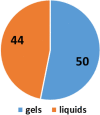Assessment of quality of alcohol-based hand sanitizers used in Johannesburg area during the CoViD-19 pandemic
- PMID: 35273314
- PMCID: PMC8908948
- DOI: 10.1038/s41598-022-08117-z
Assessment of quality of alcohol-based hand sanitizers used in Johannesburg area during the CoViD-19 pandemic
Abstract
Since the outbreak of the Coronavirus Disease 2019 (CoViD-19), the World Health Organization has recommended that, in absence of soap and water, alcohol-based hand sanitizer can be used to prevent the transmission of coronaviruses. Unfortunately, many media and anecdotal reports indicate that many alcohol-based hand sanitizers sold in South Africa are substandard and some contain potentially toxic ingredients. The study aimed to identify hand sanitizers used in the Johannesburg area during the CoViD-19 pandemic that do not contain the recommended alcohol concentration of at least 70% propanol or 60% ethanol, and contain traces of toxic ingredients. Hand sanitizers randomly collected from various traders around Johannesburg were analyzed using Agilent auto sampler coupled to a gas chromatograph utilizing flame ionisation detection. Of the 94 hand sanitizer samples collected, three preparations contained no alcohol, whereas the rest contained either ethanol, 2-propanol or 1-propanol or a combination of two alcohols. Of the alcohol-containing hand sanitizers, 37 (41%) contained less than 60% alcohol. Ethyl acetate, isobutanol and other non-recommended alcohols (methanol and 3-methyl-butanol) were also identified. Consumers are therefore warned that among the many brands of hand sanitizers found around Johannesburg, there are some substandard preparations and some that contain traces of toxic ingredients.
© 2022. The Author(s).
Conflict of interest statement
The authors declare no competing interests.
Figures
Similar articles
-
COVID-19, Overzealous Sanitizer Use, and Hair Discoloration: Case Reports.Acta Dermatovenerol Croat. 2022 Jul;30(1):57-58. Acta Dermatovenerol Croat. 2022. PMID: 36153721
-
Serious Adverse Health Events, Including Death, Associated with Ingesting Alcohol-Based Hand Sanitizers Containing Methanol - Arizona and New Mexico, May-June 2020.MMWR Morb Mortal Wkly Rep. 2020 Aug 14;69(32):1070-1073. doi: 10.15585/mmwr.mm6932e1. MMWR Morb Mortal Wkly Rep. 2020. PMID: 32790662 Free PMC article.
-
Determination and Quantification of Acetaldehyde, Acetone, and Methanol in Hand Sanitizers Using Headspace GC/MS: Effect of Storage Time and Temperature.Int J Environ Res Public Health. 2024 Jan 9;21(1):74. doi: 10.3390/ijerph21010074. Int J Environ Res Public Health. 2024. PMID: 38248538 Free PMC article.
-
Hand sanitizers: A review of ingredients, mechanisms of action, modes of delivery, and efficacy against coronaviruses.Am J Infect Control. 2020 Sep;48(9):1062-1067. doi: 10.1016/j.ajic.2020.06.182. Epub 2020 Jun 18. Am J Infect Control. 2020. PMID: 32565272 Free PMC article. Review.
-
Toxicity of chemical-based hand sanitizers on children and the development of natural alternatives: a computational approach.Crit Rev Toxicol. 2023 Dec;53(9):572-599. doi: 10.1080/10408444.2023.2270496. Epub 2023 Dec 5. Crit Rev Toxicol. 2023. PMID: 37916473 Review.
Cited by
-
In vitro assessment and comparison of quality of alcohol-based hand rubs, pre- and peri-COVID-19 pandemic outbreak in Kenya.F1000Res. 2024 May 9;12:1546. doi: 10.12688/f1000research.140226.3. eCollection 2023. F1000Res. 2024. PMID: 38778804 Free PMC article.
-
Efficacy of a New Alcohol-Free Organic Acid-Based Hand Sanitizer against Foodborne Pathogens.Toxics. 2023 Nov 17;11(11):938. doi: 10.3390/toxics11110938. Toxics. 2023. PMID: 37999590 Free PMC article.
-
Evaluation of the Efficiency of Hand Hygiene Technique with Hydroalcoholic Solution by Image Color Summarize.Medicina (Kaunas). 2022 Aug 16;58(8):1108. doi: 10.3390/medicina58081108. Medicina (Kaunas). 2022. PMID: 36013575 Free PMC article.
-
Strategy for the Choice of Disinfectants in Practical Medicine and Production.Pharm Chem J. 2023;57(2):314-317. doi: 10.1007/s11094-023-02883-4. Epub 2023 May 9. Pharm Chem J. 2023. PMID: 37313435 Free PMC article.
-
Hand Sanitizer Gels: Classification, Challenges, and the Future of Multipurpose Hand Hygiene Products.Toxics. 2023 Aug 10;11(8):687. doi: 10.3390/toxics11080687. Toxics. 2023. PMID: 37624192 Free PMC article. Review.
References
-
- Cohen SR, Ligda KO. Infectious Diseases. Basic Clinical Anesthesia. Springer Nature Switzerland AG; 2004. p. 647.
-
- Bloomfield SF, Aiello AE, Cookson B, O'Boyle C, Larson EL. The effectiveness of hand hygiene procedures in reducing the risks of infections in home and community settings including handwashing and alcohol-based hand sanitizers. Am. J. Infect. Control. 2007;35(10):S27–S64. doi: 10.1016/j.ajic.2007.07.001. - DOI
-
- Thomson E, Bullied A. Production of ethanol-based hand sanitizer in breweries during the COVID-19 crisis. Tech. Q. 2020;57(1):47–52.
-
- Chavis S, Ganesh N. Respiratory hygiene and cough etiquette. Infect. Control Dent. Off. 2019;18:91–103. doi: 10.1007/978-3-030-30085-2_7. - DOI
-
- World Health Organization. Transmission of SARS-CoV-2: Implications for infection prevention precautions: Scientific brief, 09 July 2020 (World Health Organization, 2020).
Publication types
MeSH terms
Substances
LinkOut - more resources
Full Text Sources
Medical



